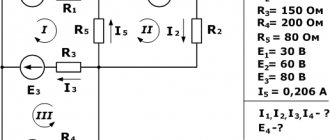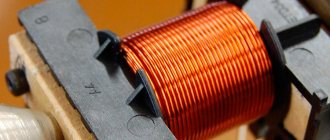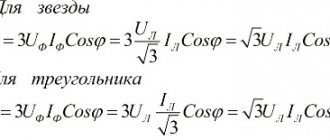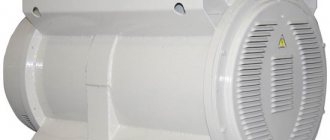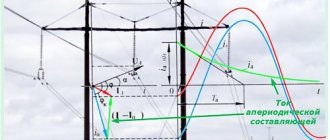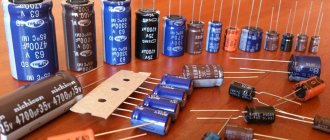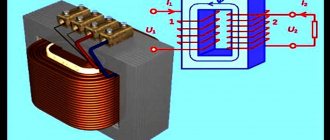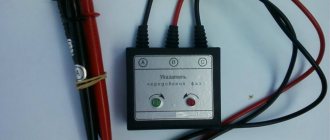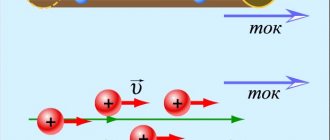Harmonics in electrical networks, causes, influence, methods of combating
The presence of harmonic oscillations in the electrical network is the result of distortion. The presence of harmonic oscillations in the electrical network is the result of distortion in the frequency of the current or supply voltage, which can be caused by the nature of the load or the power source itself. Causes of distortion: constant and intermittent nonlinear loads (operation of rectifiers, frequency converters, transformers, one-time switching on of a large consumer, such as an automatic welding machine or machine), cyclic loads (a large consumer is connected to the network at a certain time of the day), peak loads with massive electricity consumption. Often the cause of harmonic voltage oscillations is the wear and tear of equipment in the power generating industry and distribution networks (mainly old transformer substations and networks with low consumption limits).
- Sources of harmonic currents:
- Harmonic consequences and protection
- Negative consequences of harmonic currents:
- Economic consequences of harmonic currents:
Sources of harmonic currents:
— motors with soft start, control devices (frequency converters), power supplies;
— furnaces (arc, induction), welding machines;
— energy-saving lamps (fluorescent, arc, gas-discharge);
- modern household and office equipment.
Critical equipment for an AC network is considered to be equipment capable of causing harmonics corresponding to 20% of power consumption. In such cases, it is necessary to take measures to eliminate current distortions.
Harmonic consequences and protection
Essentially, harmonics are parasitic currents that equipment cannot consume or consumes partially with a negative effect. In electric motors they cause vibrations, in various networks they lead to overheating, and if the harmonic is lower than the rated sinusoidal current required for the operation of electrical equipment, then in servos, circuit breakers and other equipment they can cause false alarms.
A big problem is the premature aging of electrical insulation in networks with an abundance of harmonics. Harmonics exceeding the frequency of the rated current cause heating of the conductors, and thermochemical processes begin in the insulating materials, changing their properties. The consequence of these processes is insulation breakdowns.
Important! In the presence of a large number of harmonics, single-phase short circuits with breakdown to ground are possible. Also, a large number of harmonics leads to overload of the neutral, which reduces the degree of security of the system.
The device uses various circuits to protect against harmonics. Basic:
- the use of a resistor capable of absorbing this current and converting it into thermal energy;
— the use of capacitors (acting as a reactive power compensator);
— application of harmonic filters.
To monitor the network, modern power quality analyzers are used, capable of monitoring 10 current parameters (including distortion levels) and higher with the ability to output information to a PC.
More information about harmonics can be indicated in the following video:
Negative consequences of harmonic currents:
— overload in distribution networks;
— overload in neutrals;
— overload of transformers, generators, engines, which causes premature aging of equipment;
- noise, vibration, and as a result - mechanical destruction of incorrectly operating electric drives;
— reduction in the reliability of the electronic part, increasing the likelihood of its failure;
— interference in communication lines, communication equipment, recording devices.
Possible consequences
In the case of a constantly present factor generating harmonics, their impact can cause various negative consequences in the electrical network. Of which special mention should be made:
- Associated heating , which damages the insulation of motors, transformer windings, reduces the resistance of capacitors, etc. When a phase wire or other conductive elements are heated, irreversible processes occur in dielectrics that reduce their insulating properties.
- False activation in distribution networks leads to the shutdown of circuit breakers, high-voltage switches and other devices that respond to mode changes caused by harmonics.
- Causes asymmetry in industrial networks with three-phase sources when a harmonic occurs on one phase. What can disrupt the normal operation of three-phase rectifiers, power transformers, three-phase UPS and other equipment.
- The occurrence of noise in communication networks , the impact on adjacent low-current and power cables due to the induced EMF. The magnitude of the EMF harmonic is affected by both the distance between the conductors and the duration of their approach.
- Leads to premature electrical aging of equipment. Due to the destruction of sensitive elements, high-precision instruments lose their accuracy class and are subject to premature wear.
- Causes additional financial costs caused by losses from inductive loads, production stoppages, extraordinary repairs and premature breakdowns.
- The need to increase the cross-section of neutral wires due to the summation of harmonics that are multiples of 3 in three-phase networks.
Higher harmonics in electrical networks
The constant increase in the number of non-linear consumers in our electrical networks leads to increased “pollution of electrical networks”. The reverse impact on the network is the same problem for the energy sector as water and air pollution is for the environment.
Ideally, the output terminals of the generators output a purely sinusoidal current. Sinusoidal voltage is considered as the ideal form of alternating voltage; any deviation from it is considered network interference.
Fig.1 Reverse effects on the network caused by frequency converters.
More and more consumers are receiving non-sinusoidal current from the network. A Fast Fourier Transform (FFT) of these "dirty" current waves reveals the presence of a wide spectrum of oscillations with harmonics of varying orders, commonly referred to as higher harmonics .
Fig.2 Analysis of higher harmonics (Fast Fourier transform)
Higher harmonics cause harm to electrical networks; they are dangerous for connected consumers in the same way that contaminated water is harmful to the human body. They lead to overloads, reduce service life and, under certain conditions, can cause premature failure of electrical and electronic consumers.
Higher harmonic loading is the main cause of invisible voltage quality problems, leading to huge costs for repairs or the purchase of new equipment to replace damaged ones. An unacceptably high feedback effect on the network and the resulting poor voltage quality can thus cause disruptions in the production process, even to the point of stopping production.
Higher harmonics are currents or voltages whose frequency exceeds the fundamental oscillation of 50/60 Hz and is a multiple of this frequency of the fundamental oscillation. Higher current harmonics do not contribute to the active power, but only exert a thermal load on the network. Because harmonic currents flow in addition to the "active" sine waves, they introduce electrical losses within the installation that can lead to thermal overload. Additional losses in the electricity consumer also lead to heating and overheating, as well as a reduction in the service life of the equipment.
The assessment of the harmonic load is usually carried out at the point of connection (or transmission to the public power supply network) of the relevant energy supply organization. Increasingly, these points are called Point of Common Coupling (PCC). Under certain conditions, it may be necessary to identify and analyze the harmonic loads of certain equipment or groups of equipment to identify internal network quality problems and their causes.
Fig.3 Capacitors damaged by higher harmonics
To assess the load with higher harmonics, the following parameters are used:
Total Harmonic Distortion (THD)
Total Harmonic Distortion (THD), or total harmonic distortion, qualifies the size of the portions resulting from nonlinear distortion of an electrical signal. This is the ratio of the effective value of the higher harmonics to the effective value of the first harmonic. The THD value is used in low, medium and high voltage networks. Typically, the coefficient THDi is used for current distortion, and the coefficient THDu is used for voltage distortion.
Distortion factor for voltage
- M = serial number of the highest harmonic
- M = 40 (UMG 604, UMG 508, UMG 96RM)
- M = 63 (UMG 605, UMG 511)
- Fundamental harmonic corresponds to n = 1
Harmonics of current and voltage in electrical networks
Harmonics problem...
Any devices and equipment with nonlinear characteristics are sources of harmonics in their network. If you are faced with such equipment or have experience working in networks with harmonics, then chokes with capacitors or filter compensating units (FCU) can come to your aid. Harmonic distortion and related problems in electrical networks are becoming increasingly prevalent in distribution networks.
Problems created by harmonics.
additional heating and failure of capacitors, capacitor fuses, transformers, electric motors, fluorescent lamps, etc.;
false alarms of circuit breakers and fuses;
the presence of the third harmonic and its derivatives 9,12, etc. in neutral may require an increase in the cross-section of its conductor;
harmonic noise (frequent transitions through 0) can cause the components of control systems to malfunction;
damage to sensitive electronic equipment;
interference of communication systems.
The following sections are a description of harmonics, a characterization of the problem, and a search for a solution.
Origin of harmonic distortion
The ever-increasing demands of industry and the national economy for stability, adaptability and control accuracy in electrical equipment have led to the emergence of relatively cheap power diodes, thyristors, SCR (Silicon Controlled Rectifier) and other power semiconductors.
Nowadays, semiconductors widely used in UPS rectifier circuits, static AC-DC voltage converters, and soft starters that replaced outdated devices have changed the picture of the shape of current and voltage in electrical networks. Although solid-state relays such as thyristors have brought significant changes to control circuit design, they have also introduced the problem of current harmonic generation. Current harmonics can greatly affect power supply networks, as well as overload cosine capacitors used to compensate for reactive power (as the frequency increases, the resistance of the capacitor decreases and the current through it increases).
We have focused our attention on harmonic sources such as solid-state power electronics, but there are many other sources of harmonic currents. These sources can be grouped into three main types:
Power electronic equipment: AC frequency drives, DC drives, UPS uninterruptible power supplies, rectifiers (six-phase, Larionov circuit), converters, thyristor systems, diode bridges, high-frequency melting furnaces.
Welding, arc equipment: arc melting furnaces, automatic welding machines, lighting (DRL-mercury lamps, fluorescent lamps)
Saturable devices: Transformers, motors, generators, etc. Harmonic amplitudes on these devices are usually negligible compared to power electronics and welding equipment, provided that saturation does not occur.
Current sine wave shape
Harmonics are sine waves summed with a fundamental (fundamental) frequency of 50 Hz (i.e. 1st harmonic = 50 Hz, 5th harmonic = 250 Hz). Any complex sine wave shape can be decomposed into its component frequencies, so a complex sine wave is the sum of a certain number of even or odd harmonics with smaller or larger magnitudes.
Harmonics are long-term disturbances or distortions in the electrical network, having various sources and manifestations such as pulses, phase imbalances, surges and dips, which can be categorized as transient disturbances.
Transient disturbances are usually dealt with by installing suppression or isolating devices such as pulse capacitors, isolating (isolating) transformers. These devices help eliminate transient disturbances, but they do not help eliminate low-order harmonics or eliminate resonance problems due to the presence of harmonics in the network.
What are harmonics in electricity
The correct operation of electrical appliances, be it household appliances or industrial equipment, depends on the quality of electricity, which we are accustomed to judging by the stability of voltage and frequency, and the absence of sudden voltage surges. In this case, it is a priori accepted that the AC voltage varies strictly according to a harmonic law and represents an ideal sinusoid, but this is far from the case.
In practice, sinusoidal voltages of electrical networks are subject to distortion and instead of an ideal sinusoid on the oscilloscope screen we see a distorted signal, riddled with dips, notches and bursts. These distortions are a consequence of the influence of harmonics - parasitic oscillations that are multiples of the fundamental frequency of the signal, caused by the inclusion of nonlinear loads in the network.
Thus, the actual voltage in the network is the sum of the main signal and its harmonic components. To determine the harmonic values, the Fourier transform is used, with the help of which the original signal is decomposed into the sum of harmonic signals. The level of harmonics or the level of influence of nonlinear distortions is usually characterized by the nonlinear distortion factor.
Types and sources of harmonics
To determine the level of distortion, the frequency range from 100 Hz (2nd harmonic frequency) to 2000 Hz is usually considered. Harmonic distortion of sinusoidal signals occurs due to two types of parasitic oscillations:
- harmonics, as already mentioned, vibrations of frequencies that are multiples of the fundamental frequency of 5 Hz, which consist of even (100, 200, ... Hz) and odd harmonics (150, 250 ...);
- interharmonics, vibrations whose frequencies are not multiples of the fundamental frequency.
Distortions generated by harmonics occur due to nonlinear consumers, causing distortion of phase currents and, as a consequence, leading to undesirable changes in phase voltages. A typical example is three-phase transformers, in which the lengths of the magnetic paths for different phases differ almost twice, which requires different values (one and a half times) of magnetizing currents.
Other sources of harmonics are electric motors, which are widely used both in three-phase networks powering production equipment, and in single-phase household ones (washing machines, kitchen appliances, power tools).
Sources of interharmonics include numerous switching power supplies equipped with frequency converters. They are used everywhere today:
- in low-power chargers for gadgets;
- on TVs and computers;
- in powerful inverter welding machines.
They “saturate” the electrical network with oscillations at frequencies of 20 kHz and even higher; the frequencies of some modern UPSs can reach 150 kHz. The combined influence of interharmonics and higher harmonic oscillations causes interference.
The fifth harmonic has a frequency five times higher than the fundamental frequency. There are marks with numbers in the picture.
Negative effects and methods of protection
The appearance of harmonics in the supply network is not so harmless and can lead to quite tangible consequences. So they lead to increased heating:
- windings of electric motors, which can result in a breakdown on the housing;
- transformer windings with possible destruction of insulation and short circuit of wires;
- supply wires with gradual loss of dielectric properties by the insulation.
If a harmonic occurs on one of the phases of a three-phase network, it can cause asymmetry, which will affect the correct operation of the equipment. Harmonics lead to false triggering of distribution and protective equipment (RCDs, circuit breakers, starters), which threatens technological processes and personnel safety. The quality of communication suffers from the occurrence of higher harmonics. The main means of combating harmonics is filtering, and the filter circuit is selected based on specific requirements. These can be filters that pass only the fundamental frequency, or there can be sequential LC chains tuned to certain harmonics (for example, the fifth harmonic) and suppressing them.
See also other articles:
To carry out measurements we use modern and high-precision equipment from METREL. Based on the results of the work, you will receive a full report in accordance with GOST 32144-2013. Thanks to this, you will be able to optimize not only the electrical networks themselves, but also the equipment that operates from them.
Harmonics form switching power supplies for countless electrical appliances, uninterruptible power supplies, energy-saving fluorescent lamps, etc. A characteristic feature of a symmetrical three-phase network with balanced loads is a current shift of 120°.
Source
Harmonic protection
For protection, devices with active and passive elements are used, the action of which is aimed at absorbing or compensating harmonics in the network. The simplest option is LC filters, consisting of a linear choke and a capacitor.
Rice. 3. LC filter circuit
Look at Figure 3, it shows the circuit diagram of the filter. Its operation is based on the inductive reactance of the coil L, which does not allow the current to instantly gain or lose value. And on the capacitance of the capacitor C, which provides a gradual increase or decrease in voltage. This means that harmonics cannot sharply change the shape of the sine wave and ensure its smooth rise and fall at the RN load.
When a coil and a capacitor are connected in series with a specific selection of parameters, their complex resistance will be equal to zero for some harmonic. The disadvantage of such a passive filter is the need to form a separate circuit for each component in the network. In this case, it is necessary to take into account their interaction. So, for example, when the fifth harmonic is suppressed, the seventh harmonic is amplified, so in practice several filters are installed in a row, as shown in Figure 4.
Rice. 4. Shunt filter
Due to the fact that each chain L1-C1, L2-C2, L3-C3 shunts the corresponding component, the filter is called a shunt filter. In addition, devices with active harmonic suppression can be used as an input filter.
Rice. 5 Operating principle of active harmonic conditioner
Look at Figure 5, it shows an active filter. The power supply generates a current ips, which is affected by the non-linear load, resulting in a non-sinusoidal in curve in the network. An active harmonic conditioner (AHA) measures the magnitude of all non-linear currents iahc and supplies the same currents to the network, but with the opposite angle. This makes it possible to neutralize harmonics and provide the consumer with a first harmonic current as close as possible to a sinusoid.
Installation of any of the existing types of protection requires a detailed analysis of harmonic components, loads, crest factors and power factors for a specific network. To choose the most effective removal method and make the appropriate settings.
In this article we will look at what harmonics are, fundamental frequency and complex waveforms due to harmonics, at the end of the article we will summarize briefly on this topic.
